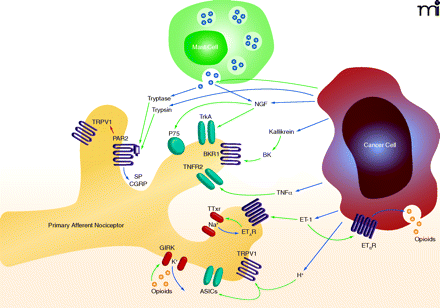
- Institution: Stanford Univ Med Ctr Lane Med Lib/Periodical Dept/Rm L109
- Sign In as Member / Individual
Mechanism of Cancer Pain

The key cellular components within the cancer microenvironment include the cancer cells, primary afferent nociceptors, and immune cells (e.g., mast cells). Cells comprising the cancer produce and secrete mediators into the cancer microenvironment that modulate nociception. Such mediators include: protons, ET-1, TNFα, NGF, trypsin, and opioids. The cancer can indirectly increase nociceptive mediators such as bradykinin (BK) or tryptase. BK production is increased by the secretion of kallikrein by the cancer cell. Tryptase is released through stimulation of mast cells by the cancer. Certain mediators, such as ET-1 can activate receptors both on the cancer cell (ETBR) and the primary afferent nociceptors (ETAR). The various mediators stimulate the associated receptors on primary afferent nociceptors to produce both nociception and antinociception. (See text for details and references. Blue arrow indicates secretion. Green arrow indicates activation. Red arrow indicates sensitization.)


